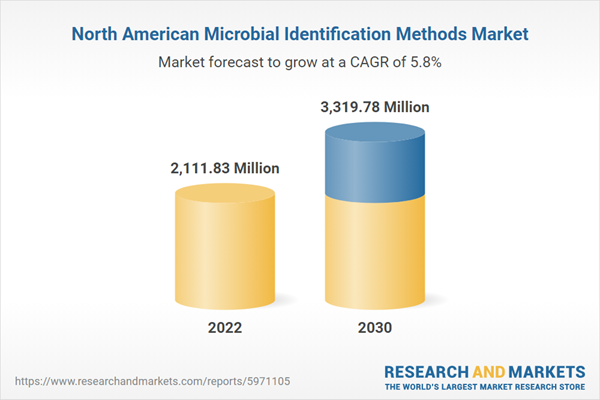Increasing Food Safety Concerns Demanding for Microbial Identification Procedure Fuel the North America Microbial Identification Methods Market
Foodborne diseases (FBD) are a prevalent and expanding public health and economic problem. The prevalence of foodborne infections is influenced by recent changes in food production and processing methods and consumers' ever-evolving eating patterns. The interaction between known pathogens during infection is one of the concerns, and new difficulties have emerged in recent years. Despite the rising adoption of chemical preservatives, cold chains, and a greater understanding of microbes, foodborne illnesses are a significant public health issue for both industrialized and developing nations. The Food Security Cluster estimates that each year, ~420,000 people die, and over 600 million people-nearly one in ten people worldwide-get sick after consuming contaminated food, resulting in a loss of 33 million DALYs in June 2022.As per the Centers for Disease Control and Prevention (CDC) 2019, every year, about 1 in 6 people in the US have a foodborne disease. Bacteria, such as Salmonella, E. Coli, Campylobacter, and Listeria, are the cause of many foodborne infections. Foodborne infections cause about 100,000 hospital admissions and 3,000 fatalities annually in the country. Additionally, every year, 4 million Canadians, or 1 in 8 of the population, become ill from contaminated food. An estimated 11,500 hospital admissions and 240 fatalities are attributed to foodborne diseases annually. Both estimates for 30 foodborne pathogens and unidentified causes of acute gastrointestinal sickness are included in the numbers. The conventional approach is cultivating bacteria using a variety of nonselective and selective enrichment techniques, followed, among other things, by biochemical confirmation. The time-to-detection is a significant limitation when testing foods, especially those with short shelf lives like fresh meat, fish, dairy products, and vegetables. Several newer detection methods use spectroscopic approaches, such as matrix-assisted laser desorption ionization-time of flight and hyperspectral imaging protocols. Thus, the increase in cases of foodborne diseases is driving the microbial identification methods market.
North America Microbial Identification Methods Market Overview
The North America microbial identification method market has experienced substantial growth in the past few years due to an upsurge in demand for accurate and rapid microbial identification across various industries such as healthcare, pharmaceuticals, food & beverages, and environmental monitoring. The growth is attributed to several factors, including the rising incidence of infectious diseases, the need for stringent quality control measures in food and pharmaceutical production, and the growing awareness of the importance of microbial monitoring in maintaining public health. The E. coli outbreak connected to frozen falafel resulted in 20 instances of sickness and five hospitalizations, according to a November 2022 update from the CDC.Furthermore, advancements in technology, the introduction of innovative microbial identification methods, and the existence of significant players are anticipated to support the market expansion in the coming years. For instance, the BD Kiestra IdentifA system, intended to automate the preparation of microbiology bacterial identification testing, received 510(k) clearance by the FDA in January 2022. In addition, Bruker Corporation, a US-based organization, introduced the MBT Sepsityper Kit IVD in January 2021 to quickly identify more than 425 bacteria from positive blood cultures using the MALDI Biotyper CA System. Additionally, automation and artificial intelligence (AI) are pivotal in streamlining the identification process, reducing human error, and improving overall efficiency. The pharmaceutical and biotechnology sectors are major contributors to the growth of the microbial identification market in North America. The need for precise identification of microorganisms for drug development, quality control, and regulatory compliance has led to a high demand for advanced identification methods. Thus, increasing demand for accurate and rapid microbial identification across various end users, rising incidence of infectious diseases, the need for stringent quality control measures in food and pharmaceutical production, and the growing awareness of the importance of microbial monitoring in maintaining public health are a few other factors driving the market in North America.
North America Microbial Identification Methods Market Segmentation
The North America microbial identification methods market is segmented based on method, type, and country.Based on method, the North America microbial identification methods market is segmented into genotypic, phenotypic, and proteotypic. The phenotypic segment held the largest share in 2022. The genotypic segment is further subsegmented into instruments, kits, reagents. The phenotypic segment is further subsegmented into instruments, kits, reagents. The proteotypic segment is further subsegmented into instruments, kits, reagents.
By type, the North America microbial identification methods market is segmented into bacterial identification system, microbial enumeration system, bacterial resistance identification systems, microbiology analyzer, and others. The bacterial identification system segment held the largest share in 2022.
Based on country, the North America microbial identification methods market is bifurcated into the US and Canada. The US dominated the North America microbial identification methods market in 2022.
Accelerate Diagnostics Inc, Avantor Inc, Becton Dickinson and Co, bioMérieux SA, Bruker Corp, Danaher Corp, Merck KGaA, Molzym GmbH & Co KG, Shimadzu Corp, Thermo Fisher Scientific Inc are some of the leading companies operating in the North America microbial identification methods market.
Table of Contents
Companies Mentioned
- Accelerate Diagnostics Inc
- Avantor Inc
- Becton Dickinson and Co
- bioMérieux SA
- Bruker Corp
- Danaher Corp
- Merck KGaA
- Molzym GmbH & Co KG
- Shimadzu Corp
- Thermo Fisher Scientific Inc
- Biolog Inc.
Table Information
| Report Attribute | Details |
|---|---|
| No. of Pages | 96 |
| Published | February 2024 |
| Forecast Period | 2022 - 2030 |
| Estimated Market Value in 2022 | 2111.83 Million |
| Forecasted Market Value by 2030 | 3319.78 Million |
| Compound Annual Growth Rate | 5.8% |
| Regions Covered | North America |
| No. of Companies Mentioned | 11 |









